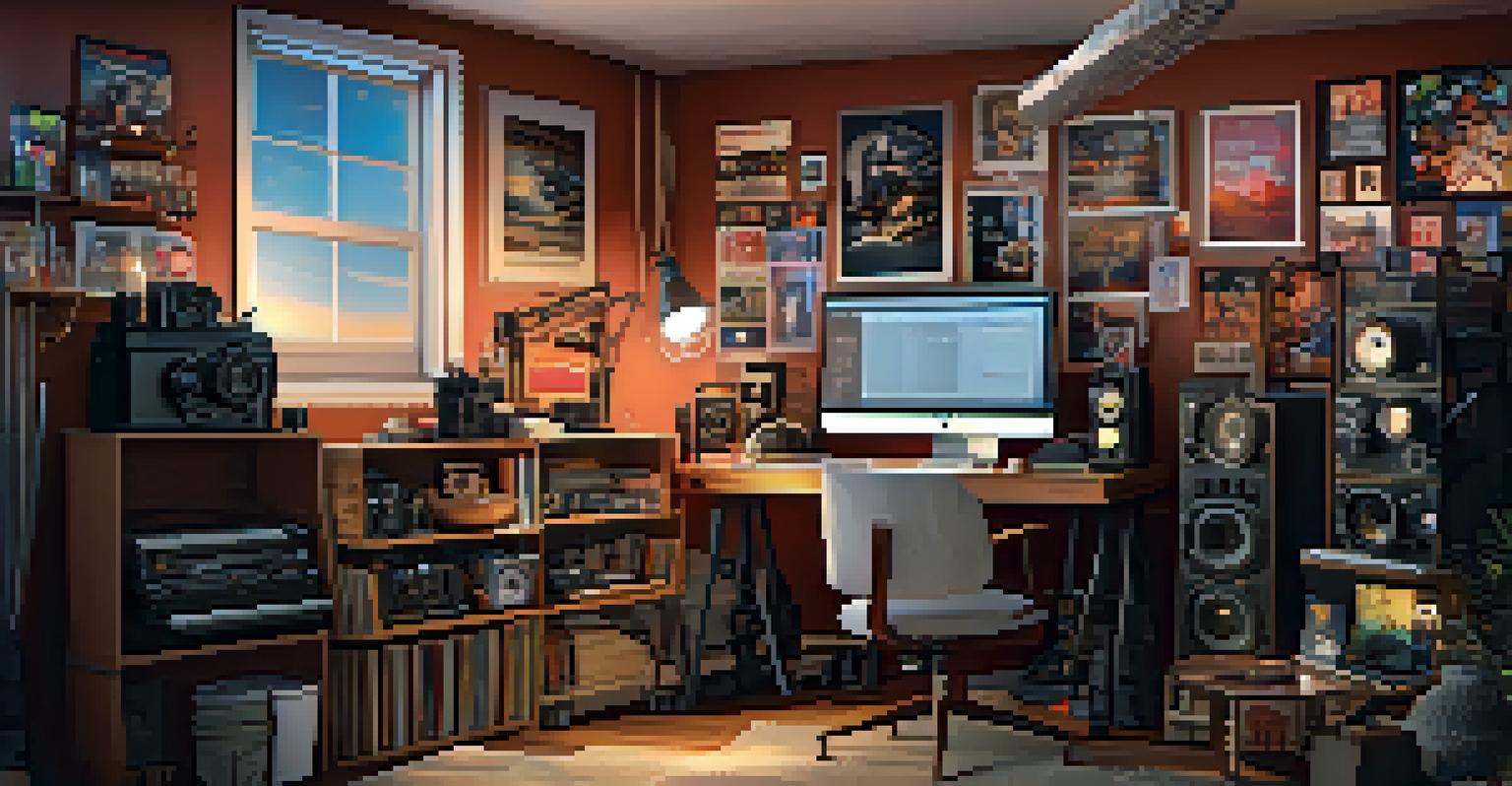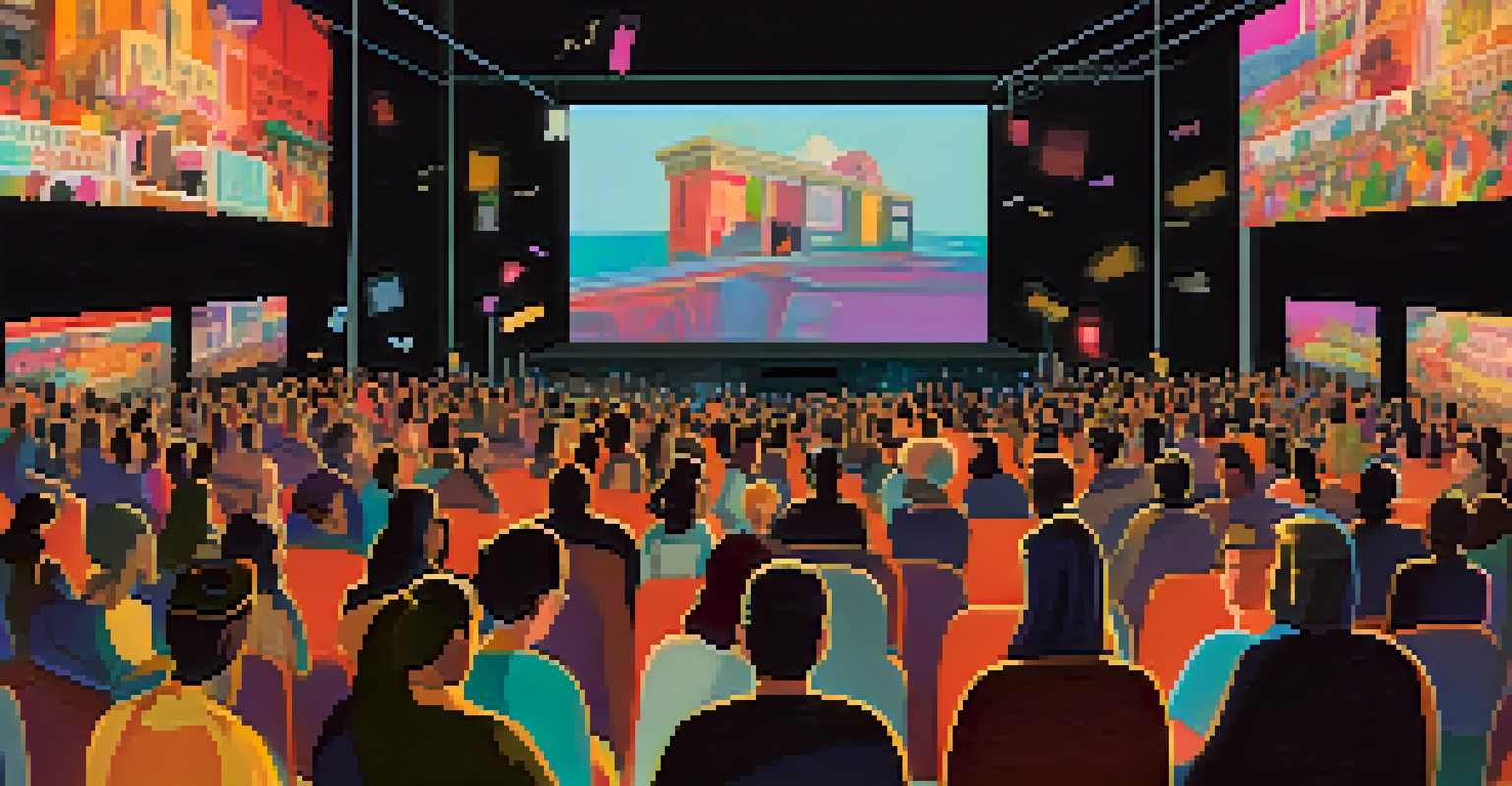Breaking Boundaries: The Impact of Experimental Films

Understanding Experimental Film: A New Frontier in Cinema
Experimental films are a fascinating departure from traditional storytelling. Unlike mainstream movies, which often follow a predictable narrative arc, experimental films prioritize artistic expression and innovation. This genre invites viewers to engage with cinema in a way that challenges their perceptions and expectations.
Experimental film is a way of getting people to think outside the box and to see the world in a different way.
By breaking the conventional rules of filmmaking, these films often blur the lines between various artistic mediums, including visual art, performance, and even poetry. This blending encourages filmmakers to explore new ideas and techniques, pushing the boundaries of what can be considered 'film.' Many creators use experimental film as a canvas to express complex emotions and abstract concepts that might be difficult to convey through more traditional means.
For instance, a film that uses non-linear storytelling can evoke a dream-like state, immersing the audience in an experience that mirrors the fluidity of thoughts and memories. This unique approach allows for personal interpretation, as each viewer may derive different meanings from the same visual collage.
The Role of Technology in Shaping Experimental Films
Technology has played a crucial role in the evolution of experimental films. With the rise of digital filmmaking tools, filmmakers now have the ability to manipulate images, sounds, and narratives in unprecedented ways. This accessibility has democratized the art form, allowing more voices to contribute to the landscape of experimental cinema.

For example, filmmakers can now use software to create stunning visual effects or edit audio in ways that were once reserved for big-budget productions. This has led to a surge in creativity, as artists experiment with new techniques and tools to tell their stories. As a result, the boundaries of what constitutes a film have expanded, encouraging an ongoing dialogue about the art of cinema.
Artistic Freedom in Filmmaking
Experimental films allow filmmakers to explore unconventional ideas and push creative boundaries without commercial constraints.
Moreover, the internet has become a vital platform for sharing experimental films with a global audience. Filmmakers can showcase their work on websites, social media, and streaming platforms, reaching viewers who might not have access to traditional film festivals. This shift not only increases visibility but also fosters community and collaboration among creators.
Challenging Norms: Themes Explored in Experimental Films
Experimental films often take on bold themes that challenge societal norms and provoke thought. They may address issues such as identity, culture, and politics in ways that are not typically seen in mainstream cinema. This thematic exploration invites audiences to reflect on their own beliefs and experiences, fostering a deeper understanding of the world around them.
The role of the artist is to make the revolution irresistible.
For instance, a film that explores the concept of gender fluidity may use abstract visuals and non-linear narratives to challenge viewers' perceptions of identity. By doing so, it opens up conversations about societal expectations and personal truths. This kind of thematic depth is what sets experimental films apart from more conventional narratives.
In this way, experimental films serve not only as a medium for artistic expression but also as a catalyst for social change. They encourage audiences to engage critically with the content, prompting discussions that extend beyond the screen and into the broader cultural discourse.
Impact on Filmmakers: The Freedom to Experiment
For many filmmakers, the allure of experimental cinema lies in its inherent freedom. Unlike commercial films, which often prioritize box office success, experimental films allow creators to take risks and explore unconventional ideas. This freedom can lead to innovative storytelling techniques that challenge the status quo.
Filmmakers like Maya Deren and Stan Brakhage have used their experimental work to carve out unique spaces in the cinematic landscape. Their willingness to push boundaries has inspired countless others to explore their artistic visions without the constraints of traditional filmmaking. This kind of creative liberation is essential for the evolution of cinema as an art form.
Viewer Engagement is Key
Unlike traditional films, experimental cinema invites viewers to actively interpret and engage with the content, fostering a unique relationship between the audience and the filmmaker.
As a result, many emerging filmmakers are drawn to experimental cinema, eager to leave their mark on the industry. This influx of new voices and perspectives enriches the medium, ensuring that it continues to evolve and inspire future generations.
Audience Engagement: The Role of the Viewer in Experimental Film
Experimental films often require active participation from their viewers, who must engage with the content on a deeper level. Unlike traditional films, where the narrative is clearly defined, experimental films leave much open to interpretation. This interactive aspect encourages audiences to bring their own experiences and emotions into the viewing process.
For example, a film that employs abstract imagery may evoke different feelings in each viewer, depending on their personal history and perspective. This subjectivity transforms the act of watching into an intimate experience, where the audience is co-creating meaning alongside the filmmaker. This unique relationship between the film and its viewers highlights the power of art to provoke thought and inspire dialogue.
Moreover, film festivals and screenings often facilitate discussions and Q&A sessions, allowing audiences to delve deeper into the themes and techniques used in experimental films. This kind of engagement fosters a sense of community among viewers, creating a shared space for exploration and reflection.
The Cultural Significance of Experimental Films
Experimental films hold a significant place in the cultural landscape, as they often reflect the tumultuous social, political, and technological changes of their time. From the avant-garde movements of the early 20th century to contemporary digital experiments, these films serve as a mirror to society's evolving values and beliefs. They often challenge viewers to reconsider their assumptions and question established norms.
For instance, during times of political unrest, experimental films may emerge as powerful commentaries on the state of the world. By using unconventional storytelling methods, filmmakers can express dissent and provoke thought in ways that resonate with audiences. This cultural relevance is what keeps experimental cinema alive and vital.
Cultural Reflections in Film
Experimental films often reflect societal changes and challenge established norms, serving as important commentaries on contemporary issues.
Additionally, as global perspectives diversify, experimental films are increasingly reflecting a multitude of voices and experiences. Filmmakers from various backgrounds are using the medium to tell their stories, enriching the tapestry of cinema with new narratives and viewpoints. This expanding cultural significance reinforces the importance of experimental films in shaping the future of storytelling.
The Future of Experimental Films: Trends and Innovations
As we look to the future, experimental films continue to evolve, embracing new technologies and trends. Virtual reality (VR) and augmented reality (AR) are emerging as exciting frontiers for filmmakers, allowing them to create immersive experiences that redefine how we engage with storytelling. This technological innovation opens up a world of possibilities for experimental cinema.
Filmmakers are increasingly exploring cross-disciplinary collaborations, merging visual art, performance, and music with film. This blending of mediums not only enhances the viewing experience but also blurs the boundaries of what we consider to be cinema. As these collaborations grow, they highlight the interconnectedness of various art forms, enriching the artistic landscape.

Moreover, as audiences become more receptive to unconventional narratives, the demand for experimental films is likely to increase. This shift in viewer preference encourages filmmakers to take risks and explore innovative storytelling techniques, ensuring that experimental cinema remains a dynamic and vital part of the film industry.